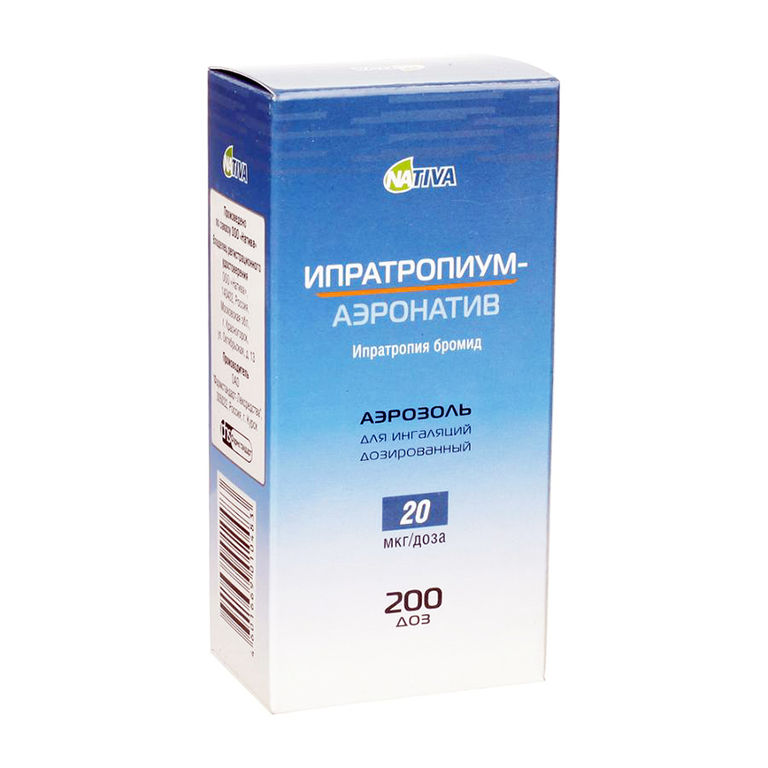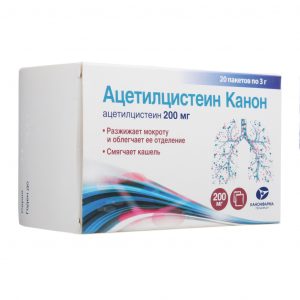Description
Pharmacological action
Pharmacodynamics. It blocks the M-cholinergic receptors of the smooth muscles of the tracheobronchial tree (mainly at the level of large and medium bronchi) and suppresses reflex bronchoconstriction. Having structural similarities with the acetylcholine molecule, it is a competitive antagonist. Effectively prevents narrowing of the bronchi resulting from inhalation of cigarette smoke, cold air, the action of various bronchospasm agents, and also inhibits bronchospasm associated with the influence of the vagus nerve. When inhaled, it practically does not have a resorptive effect – for the development of tachycardia, inhalation of about 500 doses is necessary, while only 10% reaches the small bronchi and alveoli, and the rest settles in the throat or oral cavity and is swallowed.
In patients with bronchospasm, associated with chronic obstructive pulmonary diseases (chronic bronchitis and pulmonary emphysema), improves indicators of external respiration function: the volume of forced expiration in the first second (FEV1) and the maximum average expiratory flow (FEF25-75%) increases by 15% or more already 15 minutes after administration of the drug, the maximum effect is observed after 1-2 hours, and lasts in most patients up to 6 hours.
In patients with bronchial asthma, a significant improvement in external respiration function is observed in 40% of patients (FEV1 increased by 15% or more).
Pharmacokinetics. Suction. When inhaled, ipratropium bromide is characterized by low absorption from the mucous membrane of the respiratory tract. In the digestive tract is practically not absorbed. Systemic bioavailability with the inhalation route of administration is low – about 7%, in this connection, systemic anticholinergic effects are mild. The action develops 5 minutes after inhalation and reaches a maximum after 30-60 minutes. The duration of action after inhalation is up to 8 hours.
Distribution. Less than 20% of ipratropium bromide, which enters the systemic circulation, binds to plasma proteins. It is poorly soluble in fats and weakly penetrates through biological membranes. It does not penetrate the BBB. Does not cumulate.
Metabolism. It is metabolized in the liver with the formation of 8 pharmacologically inactive and weakly active metabolites with anticholinergic action.
Withdrawal. When inhaled, ipratropium bromide is excreted mainly through the intestines. About 25% of the administered dose is excreted unchanged, the rest – in the form of metabolites. Some metabolites are also excreted by the kidneys. The elimination half-life is 3-4 hours
Indications
– chronic obstructive pulmonary disease
– chronic bronchitis
– emphysema
– bronchial asthma (mild to moderate), especially with concomitant diseases of the cardiovascular system.
Contraindications
– hypersensitivity to atropine and its derivatives
– hypersensitivity to ipratropium bromide or to other components of the
drug – pregnancy (I trimester).
Precautions angle-closure glaucoma, urinary tract obstruction, prostate hyperplasia, II and III trimester of pregnancy, breastfeeding, children (up to 6 years).
Composition
Ethanol (absolute ethyl alcohol) – 9.75 mg, citric acid monohydrate – 0.005 mg, triethyl citrate – 0.15 mg, propellant R134a (1,1,1,2-tetrafluoroethane) – 55.08 mg.
Dosage and administration
The drug “Ipratropium-aeronativ” is intended only for inhalation administration. The dosage regimen is selected individually. Unless otherwise prescribed by a doctor, the following dosage regimen is recommended for adults and children over 6 years of age: 2 inhalation doses (40 mcg) 4 times a day.
The need for an increase in dose may indicate the need for a review of the main treatment. The total daily dose should not exceed 12 inhalations (240 mcg) per day.
If inhalation is not effective enough, or if the patient’s condition worsens, consult a doctor to change the treatment plan. In case of sudden onset and rapid progression of dyspnea, you should immediately consult a doctor.
Children under 6 years old: due to that information on the use of the drug in this age group is limited, it is recommended to use the following dose (only subject to medical supervision): 1 inhalation dose (20 mcg) 3 times a day.
Inhalation instructions. Ipratropium aeronativ is intended for inhalation use only.
Before using the inhaler for the first time, or if you have not used the inhaler for a week or longer, check its operation. To do this, remove the protective cap from the mouthpiece of the inhaler, shake the inhaler well and press the bottle, releasing one jet of the drug into the air.
Inhalation: Step 1. Remove the protective cap from the mouthpiece of the inhaler.
Step 2. Shake the inhaler vigorously.
Step 3. Take a slow, full exhale.
Step 4. Holding the bottle as shown in Figure 2, tightly grasp the mouthpiece with your lips. The cylinder should be directed upside down.
Step 5. Take the deepest breath possible, simultaneously quickly press the bottom of the balloon until one inhaled dose is released.
Step 6. Hold your breath for a few seconds, then remove the mouthpiece from your mouth and exhale slowly through your nose.
Step 7. Place the protective cap on the mouthpiece of the inhaler. Repeat steps 3-6 to obtain a second inhalation dose, if necessary.
Inhaler Cleaning. Regularly (once a week) you should clean the mouthpiece of the inhaler.
Remove the metal can from the plastic case and rinse the case and cap with warm water. Do not use hot water. Dry thoroughly, but do not use heating devices for this. Put the spray can back in the case and put on the cap. Do not dip a metal can into water.
WARNING: the plastic mouthpiece is designed specifically for ipratropium aeronativ and is used to accurately dispense the drug. The mouthpiece should not be used with other metered-dose aerosols. Also, Ipratropium aeronativ with any other adapters cannot be used, except for the mouthpiece supplied with the drug.
The contents of the cylinder are under pressure. The cylinder must not be opened and subjected to heating above 50 ° C.
Side effects
Frequency determination: very often (> 1/10), often (from 1/100 to 1/10), infrequently (from 1/1000 to 1/100), rarely (from 1/10000 to 1 / 1000), very rarely (<1/10000). Allergic reactions: infrequently – skin rash, itching, angioedema of the tongue, lips and face, urticaria, laryngospasm, bronchospasm, exudative erythema multiforme, anaphylactic reactions. Effects associated with the anticholinergic action of the drug: rarely – supraventricular tachycardia, palpitations, impaired accommodation, decreased secretion of sweat glands, impaired gastrointestinal tract (GIT) motility, constipation, urinary retention (these effects are reversible). Patients with obstructive urinary tract infections are at increased risk for urinary retention. From the nervous system: very often – a headache. From the digestive system: very often – nausea, often – dry mouth, rarely – diarrhea, abdominal pain, vomiting. From the respiratory system: infrequently – cough rarely – paradoxical bronchospasm. From the side of the organs of vision: very rarely – when an aerosol gets into the eyes, pupil dilates (mydriasis), increased intraocular pressure (especially in patients with angle-closure glaucoma), angle-closure glaucoma, eye pain. Eye pain or discomfort, blurred vision, the appearance of a halo and colored spots in front of the eyes combined with conjunctival and corneal hyperemia can be symptoms of an attack of angle-closure glaucoma. Other: very often – increased sputum viscosity. Drug interaction With simultaneous use of 2-adrenergic agonists and xanthine derivatives potentiate the bronchodilating effect of the drug. Anticholinergic effect is enhanced by antiparkinsonian drugs, quinidine, tricyclic antidepressants. With simultaneous use with other anticholinergics, an additive effect is noted. Overdose Symptoms: No specific symptoms of overdose. Given the breadth of the therapeutic effect and the local method of using Ipratropium aeronativ, the appearance of any serious anticholinergic symptoms is unlikely. Minor manifestations of systemic anticholinergic action are possible, such as dry mouth, accommodation disturbances, increased heart rate. Treatment: symptomatic treatment. Storage conditions In a dark place at a temperature of no higher than 25 ° C, away from heaters. Do not freeze. Keep out of the reach of children. Shelf life 2 years. active substance ipratropium bromide drugstore112 drugstore11285 words from drugstore Prescription lekarstvennaja form aerosols for ynhalyatsyy Nativ, Russia




